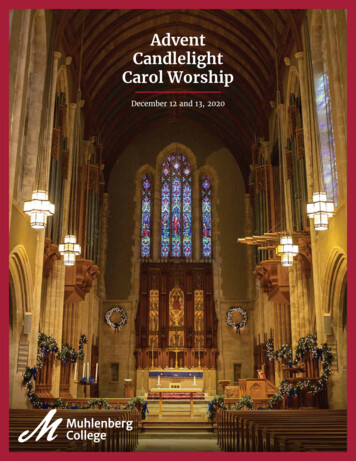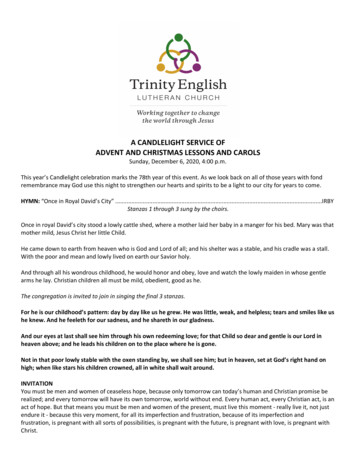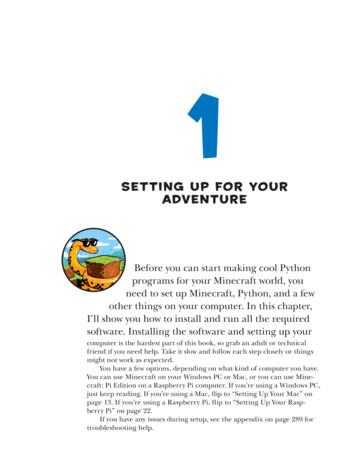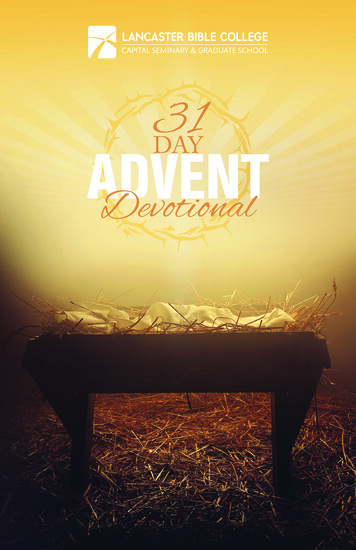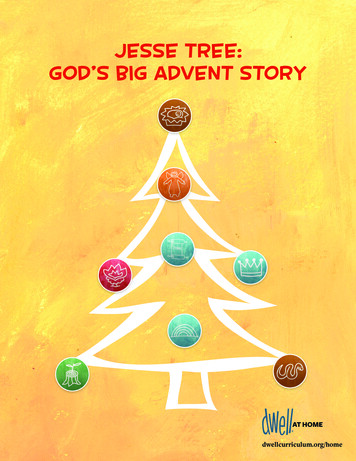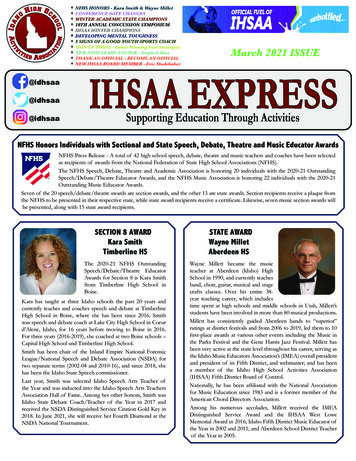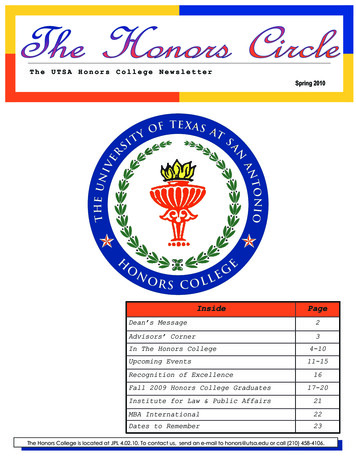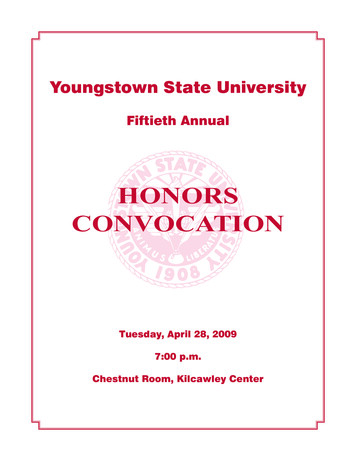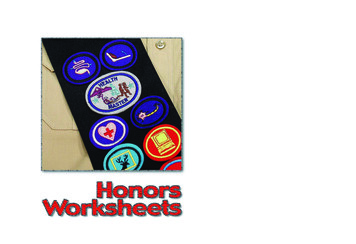
Transcription
Distributed by:AdventSource5040 Prescott AvenueLincoln, NE 685061.800.328.0525www.adventsource.orgOther printed materials available:Honors HandbookPathfinder BrochurePathfinder Staff ManualAY/Pathfinder Class Instructor’s ManualSeven Steps for Successful Pathfinder LeadershipPathfinder Club Drill ManualThe Happy PathNorth American Division Youth Ministries Director:James L. Black. Sr.North American Division Honors Committee:Allan Williamson, ChairmanTerry Dodge, SecretaryLila BartonJames L. Black, Sr.Newton CleghorneBrad ForbesRobert HolbrookDixie PlataJoe WhiteBob WongProject Coordinator: Christal GregersonInside Design: Christal GregersonCover Design: Ginger Calkins 2002 North American Division of Seventh-day Adventists
Table of ContentsIntroductionGeneral Conference HonorsArts, Crafts & HobbiesHealth & ScienceHousehold ArtsNatureOutdoor IndustriesOutreach MinistriesRecreationalVocationalOther Division Honors (listed alphabetically by division)East AfricanEuro AfricaNorth AmericanSouth PacificSouth Pacific Division / Island EditionAlphabetical IndexHonor Submission FormCheck List for Evaluating Honors
IntroductionThe Adventist Youth (AY) honors were introduced in 1928 with the objective of developing the physical, mental, and spiritual capacities of youth and adults. Each honor isdesigned to be a study that introduces a subject that has practical value, which willenhance the lifestyle of the person pursuing the honor. Honors are considered “windowsto be opened in the mode of discovery” within the philosophical framework of thechurch.This manual includes all honors currently recognized by the General Conference YouthMinistry department and also those specialized honors recognized by various Divisions.There is a wide selection of challenging honors to interest juniors through adults.Families, Pathfinder clubs, Master Guides and elementary school teachers can use honors as a tool to encourage the exploration of new interests and development of skills.Skill LevelsEach honor is assigned a skill level to guide leaders in selecting grade-appropriateness.Skill levels are divided into Level 1 (Grade 5-6), Level 2 (Grade 7-10), and Level 3(Grade 11 and above). These levels are recommendations designed to guide leaders intheir choice of honors.InstructorsSome honors require an instructor. The instructor may be a school teacher or a church orcommunity friend who is qualified to give the necessary guidance to complete the honor.An individual who serves as the instructor for an honor receives a silver diamond pinthat may be attached to their honor patch.Honor PatchesThe Conference Youth or Pathfinder Department is the source for honor patches, instructor diamonds, and advanced stars. Your Conference will have an order form and willgive you directions on how to order. Patches are usually presented at Investiture or during a church service.Advanced HonorsMany of the current honors have an advanced level. Over the next several years moreadvanced honors will be added. Honor patches are marked “advanced” with the additionof a small bronze star.Master AwardsMaster patches are earned by completing selected honors within a category.Requirements are listed at the beginning of each section.ResourcesIn past editions, a resources section has been included with each honor. Because of therapid change in availability of books, you will find the resources listed at the beginningof each section. (ie. Arts, Crafts & Hobbies, Nature, etc.)Honor Requirement UpdatesFor the latest information on honor updates and new releases go towww.pathfinders.nadadventist.org
Arts, Crafts & Hobbies IndexAboriginal LoreAfrican LoreAirplane ModelingBasketryBlock PrintingBraidingBraiding, AdvancedBread DoughCake DecoratingCandlemakingCeramicsCopper EnamelingCooper Enameling, AdvancedCounted Cross StitchCrochetingCrocheting, AdvancedCurrency (Coins)Currency (Coins), AdvancedDecoupageDigital PhotographyDrawing and PaintingFelt CraftFlower ArrangementGenealogyGenealogy, AdvancedGlass CraftGlass EtchingGlass PaintingHerbsIndian LoreIndian Lore, AdvancedKnittingKnitting, AdvancedLapidaryLeather CraftLeather Craft, AdvancedLettering and Poster MakingLighthousesLighthouses, AdvancedMacraméMetal CraftSouth Pacific DivisionEast Africa DivisionNorth American DivisionNorth American DivisionNorth American DivisionNorth American DivisionNorth American DivisionNorth American DivisionNorth American DivisionNorth American DivisionSouth Pacific DivisionNorth American DivisionNorth American DivisionNorth American DivisionNorth American DivisionNorth American Division
Model BoatsModel CarsModel RailroadingModel RocketryModel Rocketry, AdvancedMusicMusic, BeginnersMusicMusic, AdvancedNeedle CraftOrigamiPaper QuillingPaper Quilling, AdvancedPaper MachéPhotographyPinewood DerbyPinewood Derby, AdvancedPlaster CraftPlastic CanvasPlastic Canvas. AdvancedPlasticsPotteryScrapbookingScrapbooking, AdvancedSculpturingSilk Screen PrintingSilk Screen Printing, AdvancedSoap CraftSoap Craft, AdvancedStampsStamps, AdvancedString ArtTextile PaintingThatchingTie-DyeWeavingWhistleWhistle, AdvancedWood CarvingWood HandicraftSouth Pacific DivisionSouth Pacific DivisionSouth Pacific DivisionNorth American DivisionNorth American DivisionEast Africa DivisionNorth American DivisionNorth American DivisionNorth American DivisionNorth American DivisionNorth American DivisionNorth American DivisionEast Africa DivisionNorth American DivisionNorth American DivisionNorth American Division
Pathfinder’s NameAirplane Modeling 1. Build and successfully fly an airplane from a kit made of balsa woodand tissue paper, and rubberband or gas powered. 2. Build a balsa wood glider from a kit and observe its flying characteristics as related to the variable positions of the wings. 3. Make and successfully fly two different styles of airplanes using sheetsof paper between eight (20.3 cm) and fourteen (35.6 cm) inches in widthand length.Styles: 1. 2.4. Define, locate, and explain the usage of the following basic items:(Complete l stabilizerDate completedf.g.h.i.j.StrutCockpitEngineLanding gearPropellerInstructor’s SignatureArts, Crafts & HobbiesGeneral Conference2002 Edition
Airplane Modeling ChartDefine, locate and explain the usage of the NITIONLOCATED(Y/N)USAGE
Pathfinder’s NameBasketry 1. Know the names of two countries where Rattan (cane) is grown.a. b.2. Explain how to treat pithcane (reed) before weaving. 3. What tools would you use for:a.Cane basket making?b.Raffia or Indian basket making? 4. Define:a.Weaver singeingb.Crushing 5. Explain how to:a.Mend a broken spoke (stake).b.Join a weaving rod (reed). 6. Name two kinds of bases used in baskets and tell in which type ofbasket each one can be used.1.BasesTypes of Baskets2.Arts, Crafts & HobbiesGeneral Conference2002 Edition
7. Describe how to lay:a.A footridge borderb.A three-rod border 8. Do the following:a.simple weavingb.slewing andc.d.bispokingstitch a raffia base.9. Make a cane sandwich tray with a wood base. 10. Make a hot roll basket with a woven base. 11. Make a round hot pad six inches (15.2 cm) in diameter in Raffia orIndian basketry.Date completedInstructor’s SignatureBasketry2002 Edition
Pathfinder’s NameBlock Printing 1. List the tools and equipment necessary for block printing. 2. Write a paragraph on the principles of design and lettering asapplied to block printing. 3. Using a potato, carve a design incorporating your initials into it, and useit to print your initials on paper. 4. Design and print at least one greeting card. 5. Design and print one bookplate or book cover. 6. Going through the steps of designing, carving, and printing, createanother original piece of work of your choice.Date completedInstructor’s SignatureArts, Crafts & HobbiesGeneral Conference2002 Edition
Pathfinder’s NameBread Dough 1. Make a list of materials and supplies needed for dough artistry. 2. Why is it important to have clean hands and use hand lotion whileworking with bread dough? 3. Explain the different techniques of tinting and painting the dough. 4. What type of finish do you use to protect and give a glossy appearance? 5. Make at least two different flowers with leaves and arrange into a container of your choice. 6. Make one of the following using tinted dough:a.Sculpture arrangementb.Small wall plaque 7. Make one of the following:a.Kitchen refrigerator magnetb.Pinc.Choice of something you would like to makeDate completedInstructor’s SignatureArts, Crafts & HobbiesGeneral Conference2002 Edition
Pathfinder’s NameCake Decorating 1. List equipment necessary for cake decorating. 2. Learn from memory the two cake icings-butter cream and royal-andtheir proper uses.Buttercream:Uses:Royal:Uses:Name one other icing used for frosting: 3. Learn and demonstrate proper construction of the decorating tube usingparchment, wax papers, or a disposable bag. Show proper method ofinserting tip, brushing with color, filling with icing, and folding of top.What is the name of the top fold? 4. Name three essential steps to good cake decorating.1.2.3.Arts, Crafts & HobbiesGeneral Conference2002 Edition
5. Demonstrate pressure control with tubes. Learn the technique and namethe proper tip (tube) used to make the following:TechniquesTipa.Star, fill-in and borderb.Rosettec.Shell borderd."S" designe.Ribbonf.Zigzag borderg.Leaves6. Name four color techniques. Demonstrate two, including two-coloricing.1. 2.3. 4. 7. Learn to make the following flowers:a.Sweet peac.b.Rosebudd.Full American beauty roseDrop flower8. Demonstrate writing technique using two different tips and methods.Technique UsedTipMeothd1.2. 9. Decorate a doll cake or a cake prepared in a specialty cake pan usingstar fill-in method. Use at least two colors to make the design or pattern. 10. Make a special occasion cake of your choice using two or more bordersof different types, and a floral arrangement. 11. Make a heart cake using borders, florets, string work, and writing.Date completedInstructor’s SignatureCake Decorating2002 Edition
Pathfinder’s NameCandlemaking 1. Make at least five of the following:a.Free-form sand candleb.Layered colored candlec.Candle made in a moldd.Ice candlee.Dipped candlef.Dribble-wax candleg.Perfumed candleh.Pair of beeswax candlesi.Floating candlej.Candle in a container/jark.Decorated candle 2. Know the two kinds of wax used for candle making and their uses.Waxes Uses3. Know sizes of wicking and which one will burn properly in eachparticular candle.Size of wickingTypes of candles used inArts, Crafts & HobbiesGeneral Conference2002 Edition
4. When should a metal core wick be used? 5. Know the safety techniques of candle making.Date completedInstructor’s SignatureCandlemaking2002 Edition
Pathfinder’s NameCeramics 1. Tell briefly the history of early ceramics. 2. Know what is meant by the following pg.Menderh.Stain3. Explain the use of cones in kilns. 4. Know how and when to useunderglazeglazestain. 5. Know what tools are used in completing your projects in ceramics.Arts, Crafts & HobbiesGeneral Conference2002 Edition
6. Know the difference between glaze and food-safe glaze.GlazeFood-safe glaze 7. Complete two of the following using underglaze on one, and the secondone food-safe:a.Cookie jarb.Pie platec.Vased.Flower plantere.Candy dishf.Mugg.Item of your choiceNote: Candidate need not do the firing.Date completedInstructor’s SignatureCeramics2002 Edition
Pathfinder’s NameCounted Cross-Stitch 1. Have a tote with cross-stitch materials, including at least one hoop,masking tape or Fra-check, needles, and scissors. 2. What is the difference between cross-stitching, counted cross-stitch, andembroidery? 3. Know at least four stitches used in counted cross-stitch.1. 2.3. 4. 4. Cross-stitch a simple object in three different sizes of aida cloth. Mountand label the size and name of aida cloth used, stating how many flossstrands are to be used with each. 5. Make a counted cross-stitch of a quote with a border and frame it forhanging, using at least three different stitches. 6. Make at least a 5 x 7 inches (12.7 x 17.8 cm) counted cross-stitch onaida-14 of a nature scene.Date completedInstructor’s SignatureArts, Crafts & HobbiesGeneral Conference2002 Edition
Pathfinder’s NameCrocheting 1. Define and crochet the following:StSpStsRndInclDecInc 2. Make squares of at least 20 stitches of the following:a.SCb.DCc.HDCd.TRe.DTR. 3. Show how to measure stitch gauge or row gauge on sample squares. 4. Know how to care for items made out of the following:woolorlonnyloncotton 5. Know how to make a granny square, and show something you havemade using a granny square, such as a hat, scarf, pillow cover, etc. 6. Show a sample of simple edging you have made out of thread. 7. Crochet one of the following out of yarn: hat, scarf, sleeveless sweater,or slippers.Date completedInstructor’s SignatureArts, Crafts & HobbiesGeneral Conference2002 Edition
Pathfinder’s NameCrocheting, Advanced 1. Have the Crocheting Honor. 2. Crochet a round doily out of thread. 3. Make fancy hairpin lace for a pillow case or similar object. 4. Crochet a sweater (not sleeveless) or baby set. 5. Crochet an afghan or a throw rug.Date completedInstructor’s SignatureArts, Crafts & HobbiesGeneral Conference2002 Edition
Pathfinder’s NameCurrency (Coins) 1. Relate briefly the story of barter, showing three reasons why moneycame into being and naming at least ten strange forms of money used inplace of coins or currency. 2. Relate briefly the history of coinage and paper currency in your country,making sure to mention the dates of the establishment of any mints orengraving plants.
Pathfinder’s Name Candlemaking 1. Make at least five of the following: . Free-form sand candle . Layered colored candle . Candle made in a mold . Ice candle . Dipped candle . Dribble-wax candle . Perfumed candle . Pair of beeswax candles ˇ. Floating candle
